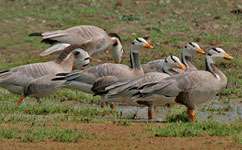Highest-flying bird crosses the Himalayas in record time

The Bar-headed goose is one impressive creature: it migrates over the immense Himalayan mountain range twice a year, holding the record for the world's highest-flying bird.
Now the latest research has revealed that the birds reach the height of Mount Everest from sea level in just eight hours.
Unlike Brent geese, which migrate from Ireland to Greenland and stop for rests on the way, Bar-headed geese don't appear to stop, instead climbing at around 0.8 to 2.2 kilometres an hour – the longest continuous climbing rates ever recorded.
"Our Bar-headed geese only stopped to apparently avoid stormy and gusty weather conditions during the day and flew at incredible rates of climb," says Dr. Lucy Hawkes from Bangor University in Wales, lead author of the study.
And rather than relying on updrafts or tailwinds to help them on their epic journeys – like most birds do – Hawkes and her colleagues were surprised to find that the birds prefer to fly early in the morning when there's less wind.
They also migrate in spring and autumn when the weather is most likely to be calm.
"We found that as well as setting out early in the morning, the birds cross the mountains during the times of year when there's a weather window – the same time that people climb Mount Everest," Hawkes says.
No other creature on Earth comes close to making a similar high-altitude migration. Indeed, to survive the same rapid change in altitude, you or I would need a lengthy period of acclimatization. "If we didn't acclimatize, we'd almost certainly get altitude sickness, edema or we could even die," adds Hawkes.
But the Bar-headed goose already has all the physiological adaptations it needs to take on such an arduous migration: their muscles use oxygen more efficiently than other birds, and their lungs are proportionally much bigger than other ducks, geese and swans.
The birds are well-studied in both their overwintering grounds in India and their breeding grounds in China, but before this latest research, no-one was quite sure which route the birds took across the Himalayas or how quickly they made the journey.
"It appears they use a route east of Mount Everest. There's a famous account of Bar-headed geese by Lawrence Swan who heard them flying over Mount Everest when he joined Sir Edmund Hilary on an expedition to the Himalaya, so we knew they fly over these massive peaks," says Hawkes.
At this altitude, the air is so thin, even helicopters struggle to fly. Earlier studies found that the geese have to flap harder, putting in 30 per cent more effort to cope with the thin air over the highest mountain range on Earth.
On their migrations from Ireland to Greenland, Brent geese can't climb at anywhere near the same rate that Bar-headed geese do, probably because they're not physiologically adapted in the same way.
"They're so slow, it's likely that they're walking as well as flying over some bits of the Greenland ice cap," Hawkes says.
Hawkes and an international team of researchers describe in Proceedings of the National Academy of Sciences how they tagged 25 geese on their northwards migration to China between mid-March to early May with GPS satellite transmitters. They also tagged 38 geese on their migration back to India.
But the researchers only managed to get successful data from five of the birds going north and seven of the southwards-migrating birds.
Hawkes says the next thing to figure out is what the limiting steps for the geese are. "What stops these birds going faster or even higher? Is it their heart, body temperature, or something else?"
This story is republished courtesy of Planet Earth online, a free, companion website to the award-winning magazine Planet Earth published and funded by the Natural Environment Research Council (NERC).
More information: Lucy A. Hawkes, et al., The trans-Himalayan flights of Bar-headed geese (Anser indicus), Proceedings of the National Academy of Sciences, published 31 May 2011, doi/10.1073/pnas.1017295108
Provided by PlanetEarth Online



















